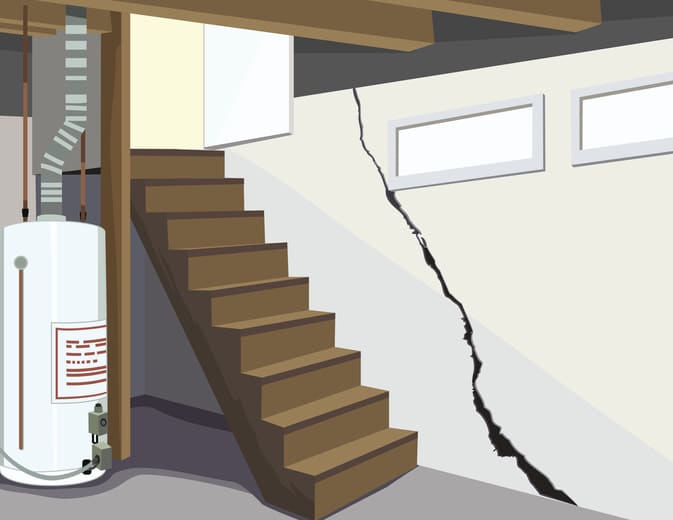
Your home’s foundation is the most essential component, as almost every other part of the house relies on a solid foundation to maintain its structure. Foundations hold your home up, distribute its immense weight into the soil, and ensure it does not split apart or sink. If your foundation starts to crack, it could spell doom for your home, or it may not be a big deal. So, how can you identify the severity of foundation cracks and get them repaired? Read on in our latest blog to find out.
Less Severe Types Of Cracks Require Minimal Repair
- Vertical Cracks: Vertical cracks are the least serious of all cracking and are common in basements and shouldn’t cause worry unless they become numerous or start to spiderweb outward. The natural settling and curing process of concrete causes these types of cracks.
- Hairline Cracks: Hairline cracks are tiny vertical cracks that are cosmetic in damage and can only be a structural problem when they grow to a few inches in length or widen from water damage.
- Diagonal Cracks: So long as the angle of the crack does not exceed a threshold of roughly thirty degrees, diagonal cracks are similar in severity to vertical cracks and can be repaired relatively quickly and inexpensively with minimal lasting damage.
- Shrinkage Cracks: Shrinkage cracks are caused by the natural settling of the concrete and are likely to appear in the first year after the foundation is poured.
Severe Types Of Foundation Cracks
- Stair-Stepped Cracks: Stair-stepped cracks are common in foundations made of blocks rather than heavy concrete slabs. These cracks can happen around the edges of the blocks and are a severe danger to your home as they resemble stairs and can quickly grow if not addressed.
- Horizontal Cracking: The most common problem that needs to be addressed for many is horizontal cracking of the foundation, often in the basement of your home. Suppose you notice any cracks of any width that run from right to left across the foundation. In that case, it is time to call a foundation repair professional, as without proper equipment and training, you will unlikely be able to repair the crack entirely.
- Structural Cracks: Structural cracks can be incredibly dangerous for your foundation. They can manifest as vertical, horizontal, or stair-stepped cracks. The easiest way to identify a structural foundation crack is by measuring the distance between the sides of the crack; a professional should address anything over 1/4 of an inch in width immediately.
How To Check Your Cracks
- Take note of the type of material cracking. Concrete, blocks, and wood foundations all have different triggers for cracking.
- Where the crack is matters, as the closer to the top of the foundation, the less likely the gap is an issue and caused by damage and, more than likely, part of the natural expansion process.
- Crack width is the most critical aspect of foundational cracking that you should be aware of. Any cracks that exceed one-quarter inch in width, no matter the direction or cause, should be inspected by a professional. Although DIY kits can fix some types of damage, if they continue to grow after repair, your foundation will likely have a severe problem.
Get Your Foundation Cracks Assessed By The Pros at Tom’s Basement Waterproofing
Tom’s Basement Waterproofing is your go to for all foundation repair and assessment needs. We are celebrating 45 years of exceptional service and can be contacted online through our contact form or by phone at (586) 776-7270 during our office hours of Monday Through Friday, 9:00 am – 5:00 pm.
